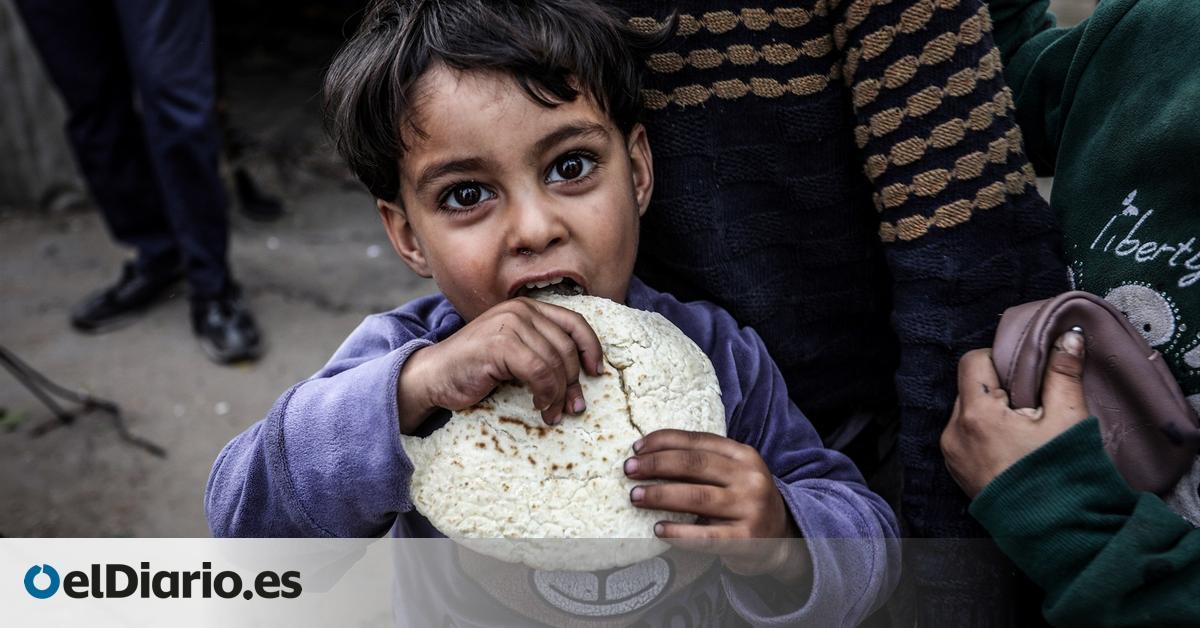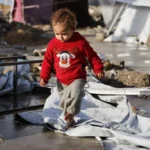
The entire world has been shocked by the death of more than one hundred Palestinians during the delivery of humanitarian aid on the outskirts of Gaza City this Thursday, when scenes of chaos, panic and despair were experienced. Hundreds of Palestinians gathered at the point where they knew the humanitarian aid trucks would pass – which have rarely reached the northern half of the Strip since the beginning of the year, where some 700,000 hungry residents remain.
It is still unclear how the 115 fatalities lost their lives, but witnesses, doctors and local authorities report that they were shot directly by Israeli troops deployed in the area. Some could have died after being run over by the same trucks that were transporting vital aid for them and their children. In the darkness of early morning, the trucks were surrounded and assaulted by a hungry crowd who only wanted a bag of wheat flour or a few cans of food donated by Arab NGOs.
Dr. Mohammed Salha, the acting director of the Al Awda hospital in Gaza City, explains to elDiario.es that on the day of the tragedy, 176 wounded people arrived at that center and 142 of them had gunshot wounds; Some were in serious condition and 27 needed surgery, but the surgery department only had emergency electric batteries to carry out “vital operations.” Seven were able to undergo surgery on Thursday, but the other 20 could not be operated on because there is no fuel, the doctor laments in a WhatsApp conversation with Olga Rodríguez.
The Gazan government (controlled by the Islamist group Hamas) speaks of a deliberate massacre of civilians and has called it “the flour massacre”; Arab and Muslim countries, and others such as Brazil and South Africa have blamed Israel. For his part, the spokesperson for the Israeli Defense Forces (IDF) in Spanish tells elDiario.es that “the soldiers carefully tried to disperse the crowd with several shots in the air.” Commander Roni Kaplan adds that Israeli forces “were there to secure the humanitarian corridor and allow the convoy to arrive at the designated unloading and distribution point.” He assures that four nights before the tragedy a similar operation was carried out “without problem.”

Pressure for independent investigation
To clarify what happened, many voices have called for an independent investigation: from the European Union, the president of the Commission, Ursula von der Leyen, has demanded transparency; and the president of the Council, Charles Michel, has called for those responsible to be held accountable. The French Government has announced that it “will support the UN call for an independent investigation” and the German Executive has said that “the Israeli Army must fully explain how mass panic and shootings could have occurred.” Both European countries have been among the least critical of Israel’s brutal offensive on Gaza, as has the US Administration, Tel Aviv’s main ally, which has assured that it will “pressure to [obtener] answers” about what happened.
But even without knowing all the details of the massacre, it highlights the dramatic and desperate situation that the population of Gaza is experiencing, after almost five months of conflict and a strict blockade imposed by Israel, which since October has prevented the flow of commercial supplies, fuel, water and electricity to the Strip – in what humanitarian organizations describe as “collective punishment” against Gazans. “Desperate civilians in Gaza need urgent help, including those in the north, where the UN has been unable to deliver aid in more than a week,” said on the social network the Secretary General of the United Nations, António Guterres, who has also requested an independent and effective investigation.
The international community seems to have opened its eyes to the crisis that has been brewing in Gaza for weeks and has almost in unison requested the entry of more aid and its delivery to the most needy inhabitants of the Strip, especially in the northern half.
The United Nations Humanitarian Aid Coordination Office (OCHA) warned this Friday that the entire population of Gaza (2.3 million people) suffers from level 3 of food insecurity, according to international standards, 1.7 Millions are already at level 4 and a quarter of the population is at the worst level, which corresponds to famine. OCHA spokesperson in Geneva, Jens Laerke, has stated that “if things do not change quickly, famine is inevitable in Gaza.” Furthermore, he recalled that it is almost impossible to produce food in Gaza, there is also no commercial flow of food and humanitarian aid trucks enter in dribs and drabs, and are exposed to serious risks.
More help and more security
The Gazan Government accuses Israel of preventing the arrival of aid to the two provinces in northern Gaza, which were devastated by the Israeli military campaign between October and December, and where troops continue to operate and control the territory, and the movements of people, as well as vehicles. The IDF spokesperson assures elDiario.es that “Israel does not limit the amount of humanitarian aid that can enter Gaza” and that the Army is “looking for a way to expand humanitarian efforts” and “increasing humanitarian operations, such as from Thursday”. However, Captain Kaplan admits that there is a problem with delivery and distribution within the Strip: “There is no problem regarding the amount of humanitarian aid (…) the only problem is the ability to distribute that aid so that “It reaches the people who need it and doesn’t let Hamas steal it.”
Aid shipments usually arrive from Egypt, through the Rafah border crossing, to Israeli territory, where they are unloaded, inspected by the Army and loaded back onto trucks. Finally, they enter Gaza from the Israeli Kerem Shalom crossing and the assistance is distributed within the Strip. UN agencies and humanitarian organizations have assured that security checks delay and complicate the arrival of aid, and tons of it sent by dozens of countries are blocked on the Egyptian side of the border.

After Thursday’s tragedy, EU leaders, as well as many governments around the world, have pointed to the need to guarantee access to humanitarian aid and the need for a ceasefire so that the distribution of that aid be safe. From Washington, State Department spokesman Matthew Miller has stated that they continue to pressure Israel to open the Erez border crossing, in the north of the Strip, which would facilitate delivery in the most devastated and needy area. “The situation in the north has been very difficult due to the difficulty of trucks traveling the distance from the south to the north and the difficulty of guarding those trucks (…) Therefore, we continue to press for a crossing to be opened in the north. north. “It remains one of our priorities,” Miller said.
Aid workers stress that main roads are destroyed by months of bombing and conflict that has left the Strip’s infrastructure in ruins. The UN humanitarian coordinator for the Palestinian Territories, Jamie McGoldrick, recently said in an online press conference that getting food to the north is a “real challenge” due to “the lack of order and congestion in the south.” of the Strip, where some of the trucks are assaulted and looted before reaching the north, and before aid can be distributed. Likewise, he considered that it is not easy for one of the northern border crossings to open, but that would be the only way to reach the population in that area. “We need to flood the north with food,” McGoldrick said from Jerusalem.
help by air
Due to the difficulties in delivering aid by land, several countries have already resorted to launching humanitarian aid from the air and the US will do so in the coming days. President Joe Biden said on Friday that military planes will bring food and supplies to Gaza, without offering further details. This option is not without controversy, as Laerke, from OCHA, has pointed out: “The delivery of stable aid by land would be more efficient and less expensive,” but the truth is that so far the amount of aid that is arriving in trucks is “insufficient and, without a doubt, inadequate to address the current food crisis in Gaza.”
Belgium has been the latest country to join Jordan’s initiative to drop aid from planes, something that the Jordanian Army has done for a long time to provide medical supplies to its field hospital built in the Strip months ago. This week, Jordan, Egypt, the United Arab Emirates, France and the United States carried out an air delivery of 160 packages of food and medical equipment in southern Gaza, in coordination with the IDF, which announced the end of said operation on Wednesday.
“In the past two days, approximately 160 food packages were airdropped over 17 different points along the coast of the Gaza Strip, from Jordanian, Egyptian, Emirati, French and American planes,” he explained in a statement. , in which he added that medical supplies and fuel were also delivered from the air to the Jordanian hospital in Khan Younis (the main city in the south, where fighting between Israeli troops and Hamas militiamen is concentrated). According to Egyptian media, Army planes have so far brought 50 tons of aid to Gaza and are preparing to drop another 6.7 tons on the north of the Strip, starting on Saturday.
Of course, sending aid by air must also have the approval of the IDF, which controls Gaza’s airspace and continues to bomb the Strip daily. More than 30,200 Gazans have died due to Israeli violence and, in recent days, the Ministry of Health has announced the death of the first ten children from dehydration and malnutrition.
Source: www.eldiario.es

